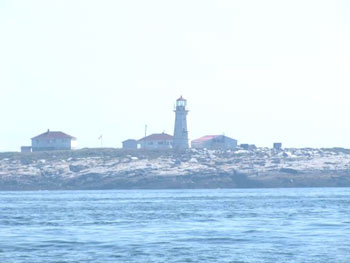John Drouin, Boats and Lobster in the Grey Zone – Part Two
by Sandy Dinsmore

Machias Seal Island, SE of Cutler in the Grey Zone. Neither here nor there, not the U.S., not exactly CA. The fishing is difficult, but good even if the deeds aren’t. Maine DMR photo
In 2002, when Drouin and his wife first drove their Wesmac 42 down the coast from Cutler, where it was a chilly 58 degrees, to Boothbay Harbor, it took six hours, but when they arrived the harbor was a balmy 72 degrees. And they liked the harbor. Drouin raced his Wesmac 42 that summer and reported that he did very well in his class.
He said he and his wife started looking for another boat because they enjoyed cruising the coast and finishing off boats. Apparently word got around that Drouin was looking at boats because someone approached him and told him he’d be interested in buying his 42.
By 2003, Drouin observed, “Fishing was changing fast at the time, meaning more fishermen and more traps in the water. The order for a 50' Wesmac was because I had great thoughts of fishing even farther offshore.”
Drouin ordered the 50-foot Wesmac in August of 2004. After hauling for two more weeks, he said, “I came in with a crate of lobsters and thought, I’d feel kind of foolish in a 50-foot boat. I didn’t need it. So I went back to Steve [Wessel] and said, ‘Let’s drop that down. I’ll do a 46.'
Drouin outfitted his 46 with 1,000 horsepower engine (most Wesmacs had 850 horsepower engines), said he was one of the first to do that, and launched the boat in 2005. He won his class in 2005-2006 and said he considered racing a lot of fun. As for cruising, he said, “We had a full head, shower, stove, sink, cupboards, the works.”
The rise in the price of fuel in 2008, though, put the kibosh on cruising and racing for the Drouins. Nevertheless, Drouin kept the Wesmac 46 for ten years. Then in 2014 while meeting with his accountant, it became clear that he had taken what boat depreciation he could on the 46, and, as he said, “one thing led to another.” His accountant asked what he could sell the boat for and Drouin replied, “Probably what I’ve got in it.” With which he started looking around once again. “Steve could get me a hull, and a finisher could finish it in the time frame,” he said. “Billings could get me an engine. All the pieces of the puzzle were falling into place wonderfully. I thought, Fine. Good. Do it.” The spring of 2015, Drouin got his new 46-foot Wesmac Superwide.
The Superwide, at a width of 17 1/2 feet, is just what Drouin needed because since 1989, he has fished the Grey Zone, that contested fishing area from Grand Manan Channel to and past Machias Seal Island, where his Canadian competition fish with boats that average 20 feet wide. Drouin also noted that the 46 gave him more room than the 42 and was more comfortable on blowy days. (There is no Canadian LFA for the Grey Zone. It is open except for a four-day period in November. No AAA map of Maine shows Machias Seal Island. Fishermen use chart #13325.)
The Grey Zone area has been contested by both countries since the 1600s, and actually, Drouin said, even before that. He cites what he calls a misinterpretation of where everybody thought they were, but said the Treaty of Ghent “supposedly changed the law.”
Apparently, Drouin said, “The Canadians said basically, “We’ll give you Eastport,” and the Americans said, “Okay, you can have that side there,” referring to some of the islands in Passamaquoddy Bay.
Both countries claim Machias Seal Island and although Canada claims it has had a presence on the island since 1892, during World War II, the United States stationed Marines there.
Both Maine and Canadian fishermen fish these contested waters, but the Grey Zone is not an easy place for fishermen of either country to fish. There are too many boats fishing in too small an area, and almost every day a fisherman will get his gear caught in someone else’s gear or he’ll set over another fisherman’s gear. There are constant problems. It’s a difficult situation that both Maine and Canadian fishermen put up with because the fishing is good and the quality of the catches make it worth it financially.
After his many years of fishing and his eight surgeries, mostly to his ankles and feet from trying to stay balanced and rigid on the deck of a constantly moving fishing boat, Drouin wonders what he’d be doing if he hadn’t become a fisherman.
